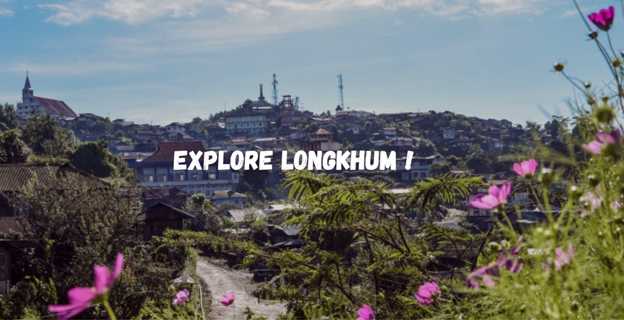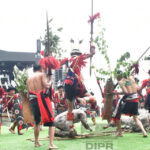Picture a village nestled amidst lush green hills, offering breathtaking views of surrounding valleys. Envision a place where the air is crisp and pure, and the people exude warmth and hospitality. Imagine a village where you can connect with nature and experience the rich culture and traditions of the Ao people.
This is Longkhum, a legendary village in the Mokokchung district of Nagaland.

Nestled in Nagaland’s Mokokchung district, Longkhum is a legendary village known as the “Ao-funemro” or Vanguard Village, a title earned during the headhunting era. Perched at an impressive 6,500 feet above sea level, Longkhum proudly boasts the title of being the highest-altitude village in the Ao country, giving its visitors an unparalleled vantage point to soak in the splendor of the surrounding hills and valleys. With sprawling boundaries that extend to Lotha Villages in the west and Sumi Villages in the south, Longkhum stands as the largest Ao Naga village in terms of land area, further enhancing its allure.
As with other Ao Naga villages, Longkhum pulsates with life during festivals such as Moatsü and Tsüngremmung. These annual festivities bring the community together, fostering a sense of unity through traditional feasts, captivating displays of traditional songs and dances, and friendly traditional games.
Longkhum’s allure thrives on the beauty of its natural landscapes and the harmony between its people and their traditions. Longkhum beckons travelers with an enchanting promise: “Your soul stays back on your first visit. You have to come back to retrieve your soul.” It’s where the past and present merge, nature’s wonders unfold, and the spirit of community and tradition thrives alongside the lush landscapes that envelop it.
But Longkhum isn’t just a realm of cultural richness and scenic splendor; it has also earned a contemporary distinction. In 2004, the Department of Horticulture, Government of Nagaland, declared it the ‘Vegetable Capital’ of the state. During the harvest season, industrious farmers of Longkhum village produce bountiful yields of tomatoes, small potatoes, chili peppers, and cabbage. Tomatoes, in particular, stand as a major commercial crop for the region, with Longkhum exporting its produce to neighboring districts like Kohima and Dimapur, and beyond.
Longkhum beckons tourists seeking an authentic connection with nature and a glimpse into the vibrant culture and traditions of the Ao Nagas. It is a destination that harmoniously blends natural wonders, cultural richness, and warm hospitality.
Visitors can get in touch with the Longkhum Tourism Committee on the number 7005426278. Longkhum Tourism has a presence in social media – including Facebook, Instagram and YouTube. The village also has its website: www.explorelongkhum.com
Places of Tourist Interest in Longkhum

One of the most captivating attractions for tourists is the Lunglangba, also known as the Stone Ladder. This natural stone ridge winds its way through a stunning rhododendron forest, creating a truly unique experience. Lunglangba holds deep cultural significance as a sacred site where ancient rituals and sacrifices took place before and after battles. The god of Longlangba was revered as supreme by the local people, and it’s believed that the holes in the stones were pierced by the spears of warriors during epic battles with gods like Jangjanglong, Mekürang, and Kifolong.
But that’s not all – as you explore Longlangba, you’ll also discover the imprints of Jena and Etiben, the beloved love birds of the Ao tribe from Mopungchuket Village. They are often referred to as the Romeo and Juliet of the Aos, adding a touch of romance and intrigue to this remarkable destination. Immerse yourself in the rich history and enchanting legends of Longlangba.

Discover the legendary “Living Mug” at Longkhum, a remarkable natural spring that’s said to possess miraculous healing properties. According to local lore, the water that flows from these rocks has the power to restore health and vitality. Science supports this belief, as the water absorbs valuable minerals from the surrounding rocks, offering long-term health benefits. Join countless tourists who visit this enchanting site to collect water in their bottles, seeking its rejuvenating effects.

Explore natural caves that plunge to depths of 50 to 100 feet and experience a truly one-of-a-kind journey into the heart of Mother Nature’s mysteries.

Discover the awe-inspiring Eagle’s Cave, nestled within majestic cliffs, a place steeped in legend as the sacred abode of the soul. According to the Ao people’s belief, souls are reborn as majestic eagles, and this natural wonder is considered their tranquil resting place during their ultimate journey. Explore this mystical site, where nature and spirituality intertwine.

This captivating hilltop was once home to a formidable fortress, and it now offers breathtaking vistas of the surrounding landscape. Don’t miss the opportunity to ascend the AKM Jubilee Tower, which stands as the village’s highest point. From here, you’ll be treated to panoramic views of lush farmlands, rolling ranches, all set against the majestic backdrop of towering mountain ranges. Come and discover the enchantment of Mata Kimung – where history, natural beauty, and adventure converge.

Nestled upon a picturesque hillock, lies a hallowed place where the indomitable spirit of Mr Imkongmeren, a revered Naga freedom fighter and the inaugural Vice President of the Naga National Council (NNC), finds eternal repose. Pay homage to this remarkable figure and explore the captivating history that unfolds in this serene and storied spot.

A picturesque hillock that serves as the perfect resting point after a challenging ascent. This location derives its name from a fascinating historical event which holds significant importance in the socio-cultural context of Longkhum Village. It is here that the wedding ceremonies were conducted. A system opposite to that of the dowry system was practiced by the villagers when the husband must give his potential father-in-law some property or money to take the daughter to wife, this amount or material things called the ‘Bride Price’ was given to the new father-in-law at a place called Achendang.

A magnificent work of woodcraft, skillfully carved from a single tree trunk. This exceptional instrument, used to beat rhythms during festive celebrations and to sound the alarm in times of danger, is a testament to the rich cultural heritage of the village.

A village in ruins, located approximately 5 kilometers from Longkhum. The remnants of this village tell a story through the shattered earthen pots, weathered attire, and the once-standing sharpening stone near the ‘morung.’ Beneath the mystical Changmutsü Lung stone lies a deep-rooted belief that small pebbles of various shapes and sizes mysteriously shift from their positions, only to return to their original spots after days or weeks. Because of this phenomenon, it is affectionately known as the “living stone” or “Taküm Lung.” Explore the enigmatic history of Reto, where the past comes to life through these intriguing artifacts and natural wonders.

A few kilometers from the village center lies the stunning Tzümeya Tzüin waterfall. Its grandeur is such that it cannot be fully captured within the confines of a camera frame. To reach this captivating spot, it’s advisable to enlist the services of a knowledgeable local tourist guide.

It is in the months of October and November that the Cherry Blossoms bloom to their full glory which are planted alongside the route to Longkhum. During this time of the year, local tourists and photographers flock into the village to capture nature’s overwhelming beauty which is also short lived.

Planted during the British Era in 1945, the pine grooves add to the many scenic sites of Longkhum Village. Running parallel on both sides of the stairway, it is one of the favorite sites for photography.
(With inputs from www.explorelongkhum.com)



